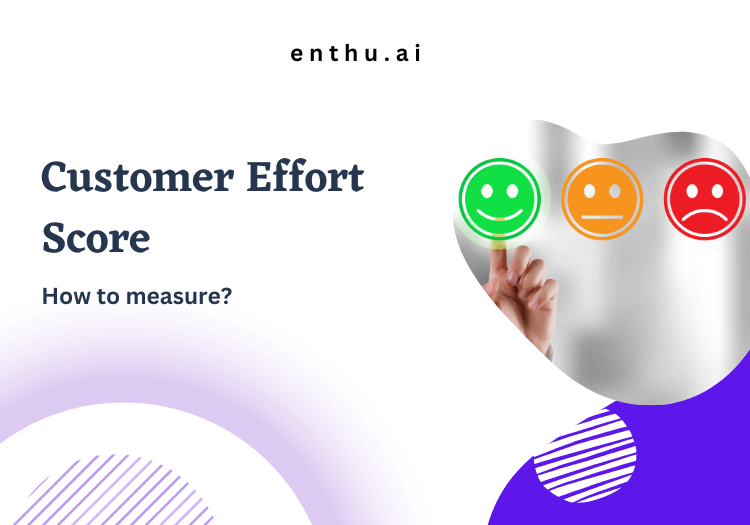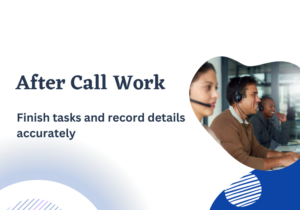Explore everything you need to know about the customer effort score.
Putting yourself in your customers’ shoes is critical if you truly want to understand their experience with your company.
Calculating the Customer Effort Score (CES) allows you to measure just how much effort your customers are putting in when interacting with your business.
By surveying customers and crunching some numbers, you gain insight into how easy (or difficult) you’re making it for people to get service, sales, and support.
High CES shows you’re making clients work too hard. Low CES demonstrates you’re minimizing customer effort.
A. What is customer effort score (CES) and why it matters?
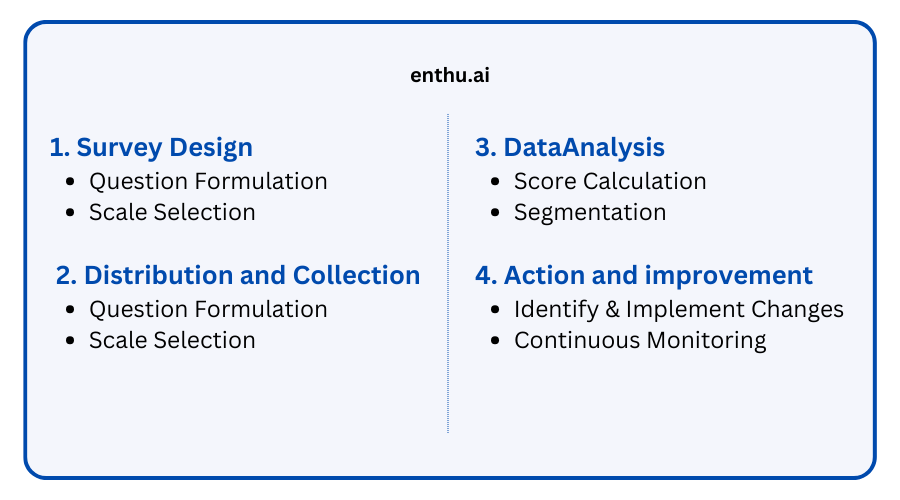
The customer effort score (CES) is a metric used to measure the level of effort your customers feel when they get an issue resolved or to get what they need from your business.
This important score provides insight into the ease and convenience of your customer service experience.
- CES is measured on a scale of 1 to 5 or 1 to 7, with 1 indicating very low effort and easy service, and 5 or 7 indicating high effort was required.
- The lower the CES, the better the customer experience. A score of 3 and below is considered good.
- It matters because the easier you make it for customers, the happier they will be. Higher CES leads to lower customer satisfaction and risks losing business.
So in short, CES allows you to quantify how easy or challenging your customers perceive your service to be. Tracking it over time shows if you are improving.
B. Why does customer effort score matter?
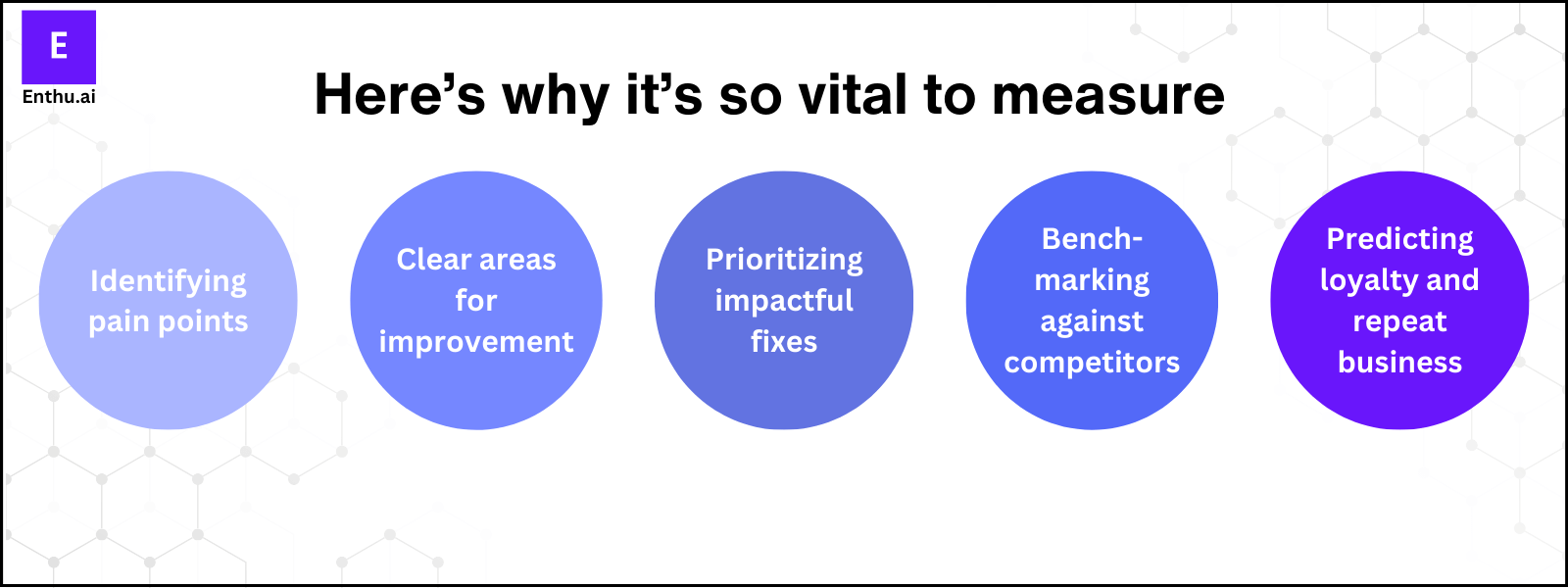
1. Identifying pain points
Customer Effort Score helps identify where customers face difficulties in their experience, allowing businesses to simplify processes and make the journey smoother.
2. Clear areas for improvement
Voice of customer analysis provides clarity on CES as in specific areas that need improvement, guiding businesses to focus on enhancing customer satisfaction by addressing pain points.
3. Prioritizing impactful fixes
By measuring customer effort, businesses can prioritize and implement fixes that will significantly impact the overall customer experience.
4. Bench-marking against competitors
CES allows businesses to compare their customer experience against competitors, helping them understand where they stand in the market and identify areas for differentiation.
5. Predicting loyalty and repeat business
High CES scores often correlate with customer loyalty and repeat business, making it a valuable metric for predicting and fostering long-term customer relationships.
Put simply, CES customer effort score gives you crucial insight into customer perceptions so you can identify and resolve friction points. This drives satisfaction, retention, and growth.
Now that you know what it is and why it’s important, let’s look at what makes a good score.
C. What is an ideal effort score?

When it comes to customer effort score (CES), there’s no definitive answer for what constitutes an “ideal” score. A lot depends on your industry, service type, and specific business goals.
However, most experts agree that a good target CES is under 2.0.
- A score under 2.0 indicates that your customers find it easy to do business with you. They don’t have to put in a ton of effort to get an issue resolved or find what they need.
- As a benchmark, many leading companies have an average CES of 1.5 or lower. Top performers in industries like tech support or customer service may have scores in the 1.2 – 1.3 range.
- A CES above 3.0 is a red flag that customers are struggling with. It likely signals complicated processes, confusing interfaces, or representatives who can’t address needs quickly.
While under 2.0 is a reasonable goal, don’t get hung up on a specific number. Focus on continuous incremental improvement. Aim to lower your CES over time.
Even small gains like going from 2.3 to 2.1 mean customers are expending less effort.
And remember, CES is just one piece of the puzzle. Use it together with metrics like customer satisfaction (CSAT) and net promoter score (NPS) to understand the complete picture of the customer experience you deliver.
D. When to use customer effort score
The customer effort score (CES) is a call center metric you can use to gauge how easy – or difficult – it is for customers to get issues resolved with your company.
Use the CES throughout the customer journey to identify pain points and opportunities to improve.
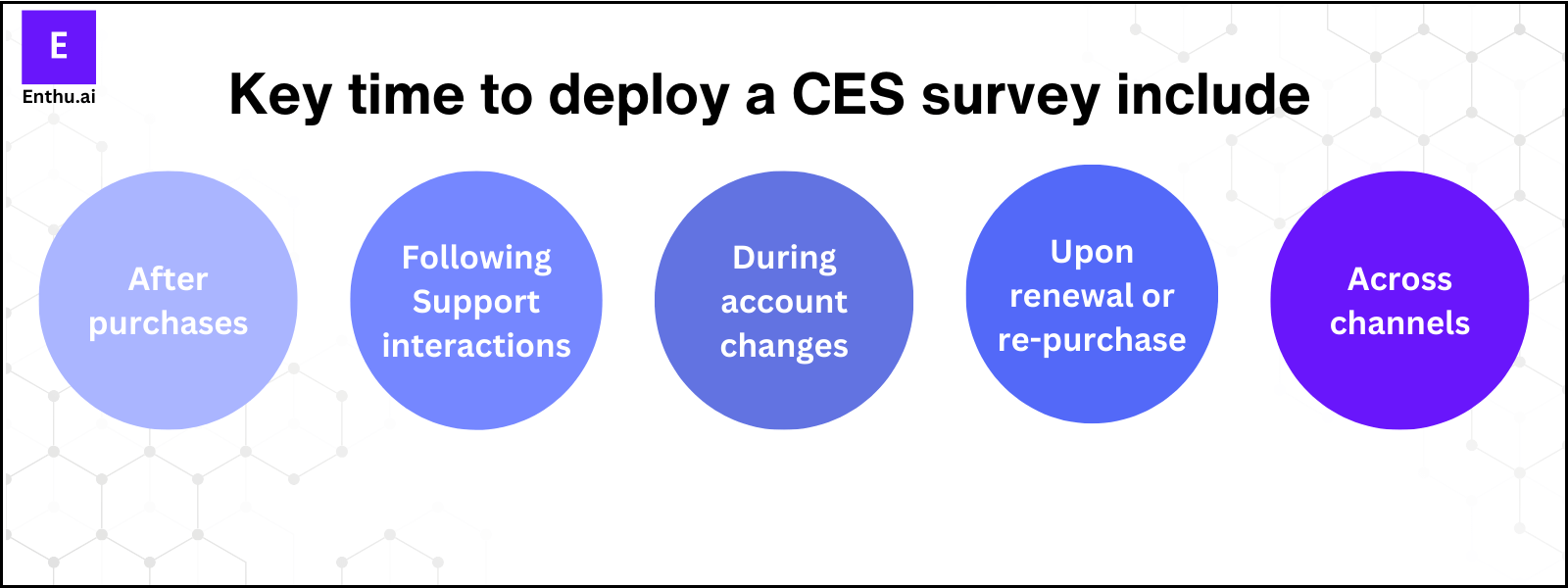
1. After purchases
Check the post-purchase experience by asking customers to rate the effort involved in buying, paying, onboarding, or setting up your product or service.
2. Following support interactions
Measure how much effort it took to resolve an issue via phone, email, chat, self-service, or social media support.
3. During account changes
Assess the difficulty of tasks like updating payment information, canceling a subscription, or modifying an existing order.
4. Upon renewal or re-purchase
Understand the effort involved in continuing or expanding the customer relationship.
5. Across channels
Compare CES scores for different channels to double down on the ones creating seamless experiences.
No matter when you collect your CES data, the most important next step is taking action on the customer feedback.
Identify areas of friction, prioritize fixes that will have the most significant impact, and continue measuring CES over time to track improvements.
With some strategic survey timing and process improvements guided by the CES metrics, you can decrease customer effort and increase long-term satisfaction.
E. Customer effort score questions
A crucial part of calculating the Customer Effort Score is asking the right questions in your survey.
The questions should be simple and focused on the effort the customer had to expend to resolve an issue or meet their needs.
Some sample CES survey questions include:
- How much effort did you personally have to put forth to handle your request?
- How easy was it to handle your issue with our company?
- How difficult was it to get the service you needed today?
Use a scale of 1 to 5 or 1 to 7 where 1 means very low effort and 5 or 7 means very high effort. This makes it easy for customers to respond. You want a score closer to 1.
The exact wording can be adjusted, but the focus should stay on the effort involved from the customer’s perspective. You want to know if they had to call multiple times, get transferred, explain their problem repeatedly, etc.
This indicates how easy or challenging your customer service experience is for them.
Sometimes a follow-up question can provide additional context, such as:
What particular area was most time-consuming or frustrating?
This gives you insight into pain points.
Keep your CES survey short, usually no more than 3 questions. You want a high response rate so you can start making positive changes in areas that need improvement.
This metric is all about understanding the customer experience from their point of view.
F. Customer effort score calculations
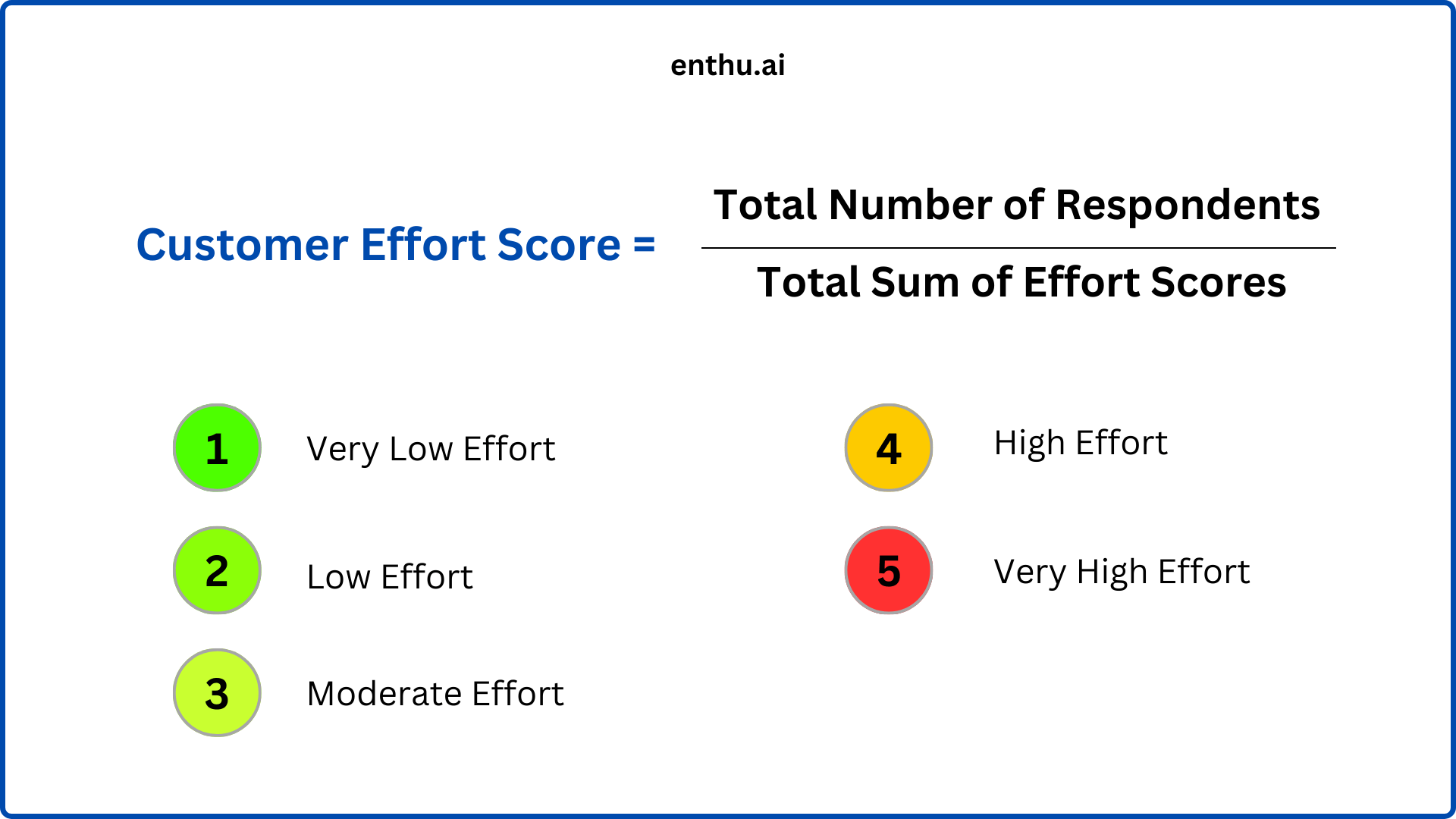
1. Assigning values to responses
To calculate a customer effort score using the customer effort score scale, you first need to assign point values to each possible survey response.
A typical scale is:
- Very easy = 100 points
- Easy = 80 points
- Neither easy nor difficult = 60 points
- Difficult = 40 points
- Very difficult = 20 points
The higher the points, the less effort required by the customer to resolve their issue or get their question answered.
2. Averaging survey responses
Once you have point values for each response, add up the total points and divide by the number of survey responses to calculate the average customer effort score.
The sum of CES scores/no of responses
For example, if you had these five survey responses:
- Easy (80 points)
- Very easy (100 points)
- Difficult (40 points)
- Neither easy nor difficult (60 points)
- Easy (80 points)
You would add up the point values (80 + 100+ 40+ 60+80= 360 points) and divide by the number of responses (360/5 = 72 points average).
The maximum possible score is 100, so this fictional company has some room for improvement, with an average CES of 72.
3. Tracking over time
The most valuable use of customer effort score is to track it over time.
This allows you to see the impact of any changes you make to improve customer experience. Focus on the trends rather than individual data points.
G. Significance of customer effort score in contact centers
Customer Effort Score (CES) is crucial in contact centers as it directly reflects the ease or difficulty customers face during interactions.
A low CES indicates streamlined processes, enhancing customer satisfaction, while a high CES signals potential areas for improvement in service delivery and efficiency.
Measure your customer effort score by analysing and listening your customer calls.
Enthu.AI, a conversation intelligence software, significantly contributes to CES by monitoring and providing you detailed call analysis.
Enthu.AI helps you identify pain points, optimize processes, and ultimately reduce customer churn and customer effort for a smoother experience.
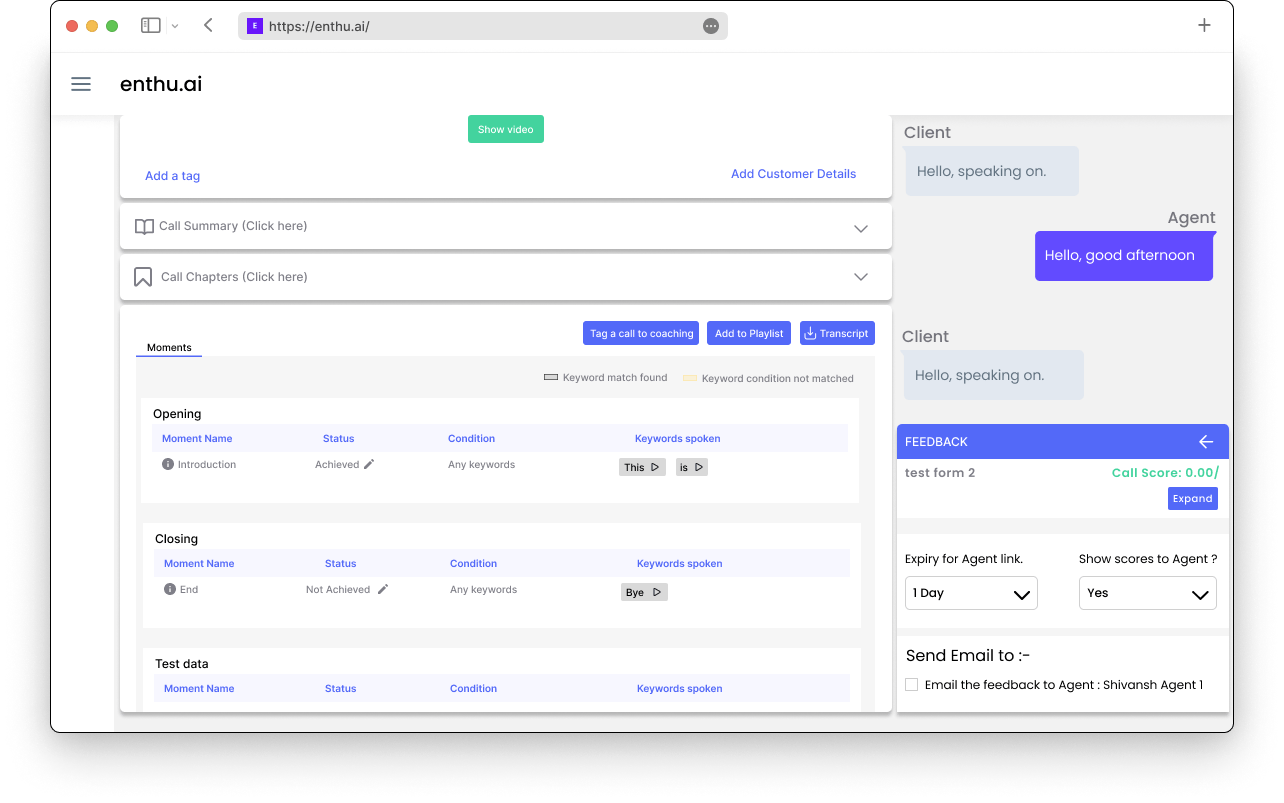
Conclusion
So, where does this leave you?
Hopefully with a better grasp on what the customer effort score is, why it matters, how to calculate it, and how to use it to improve experiences for your customers.
By regularly surveying clients and tracking CES over time, you gain insight into the ease and convenience of doing business with you.
This allows you to identify pain points and make positive changes.
Rather than guessing what customers think, you can leverage hard data to guide CX decisions. Ultimately, the more effortless you make it for customers, the happier they will be.
That pays off in the form of increased NPS and positive word-of-mouth.
So implement these tips, CES score calculation regularly, and start optimizing. Your customers will thank you.
1. How is customer effort score calculated?
The Customer Effort Score is calculated by asking customers a simple question like “How easy was it to get what you needed?” and having them rate it on a scale. The formula is straightforward: The percentage of customers who found it “easy” or “very easy.”
3. What is a good CES score?
A decent CES (Customer Effort Score) usually varies between 0 and 100, with higher ratings indicating better customer experiences. A score closer to 100 indicates that customers will put in less effort to achieve their goals, fostering customer satisfaction and loyalty.
3. What is the difference between NPS and customer effort score?
Net Promoter Score (NPS) is a metric that analyzes overall customer loyalty and satisfaction based on the likelihood of recommendation. The Customer Effort Score (CES) measures the ease of customer experiences. NPS focuses on sentiment, whereas CES evaluates the ease of engagement.
